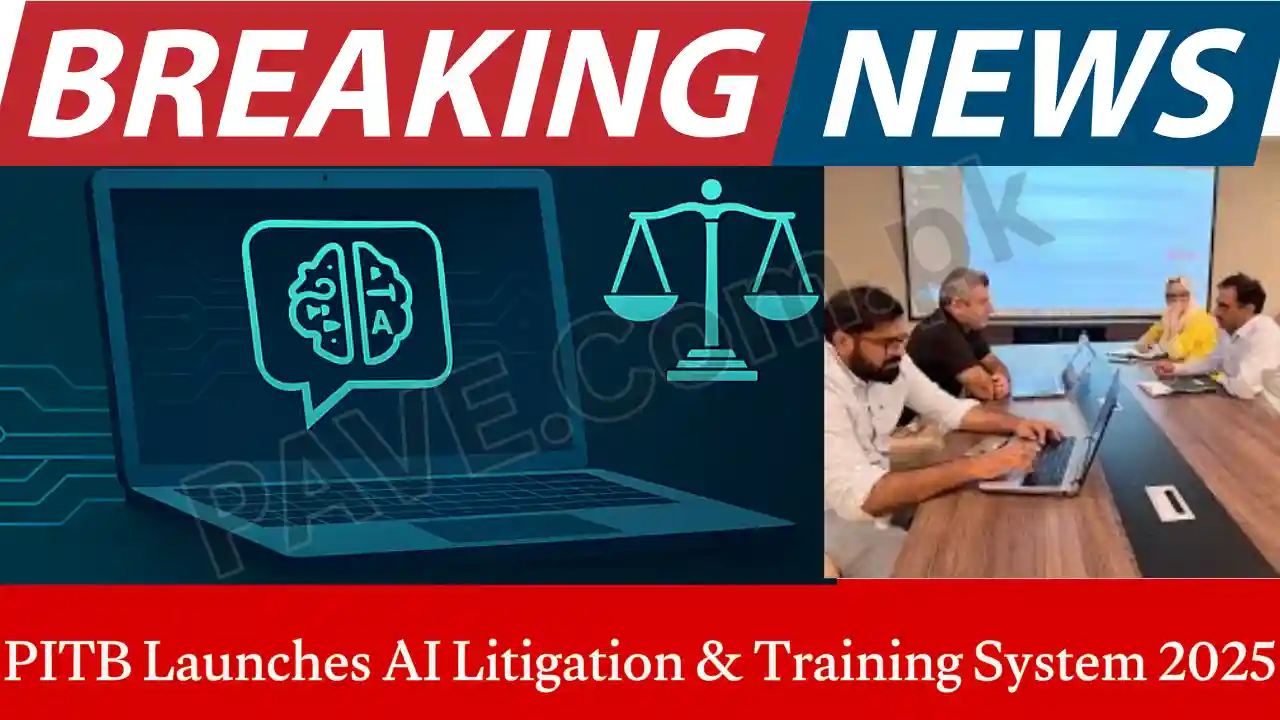PITB Launches AI Litigation & Training System 2025 to Digitize Legal Case Management

The Punjab Information Technology Board PITB Launches AI Litigation & Training System 2025, a transformative digital platform designed to modernize legal case management across government departments in Punjab. This forward-thinking initiative aligns with Pakistan’s broader digital governance vision, targeting the root causes of long-standing judicial delays, documentation inefficiencies, and fragmented departmental coordination. Through AI-powered automation, this system promises faster reporting, better transparency, and more efficient legal workflows.
For decades, government litigation in Pakistan has struggled with challenges such as missing documents, delayed court responses, fragmented communication channels, and manual paperwork. These issues significantly contribute to case backlogs and repeated adjournments in courts. By introducing an AI-driven platform, PITB aims to streamline these processes, ensuring that critical case information is securely stored, easily accessible, and intelligently processed.
A major highlight of this system is its ability to generate AI-based case summaries, extract key information from court orders, and send automated reminders ahead of upcoming hearings. Such capabilities reduce administrative pressure on officials, allowing legal teams to prepare well-structured responses without unnecessary delays. The system also maintains digital logs, ensuring that both actions and inactions are fully traceable for accountability and audit purposes.
In addition to litigation management, PITB’s initiative introduces a comprehensive training module to enhance the digital skills of legal officers, compliance staff, and government representatives. This training ensures smooth adoption, promotes standardized documentation practices, and improves courtroom preparedness. With continuous learning tools built directly into the platform, officials can master digital procedures faster than ever before.
Overall, the AI Litigation & Training System 2025 represents a critical leap forward in Pakistan’s ongoing journey toward paperless governance. By embracing artificial intelligence, cloud-based storage, and automated reporting, the government is actively reducing legal inefficiencies while boosting performance visibility. If successfully expanded to district and provincial levels, this initiative has the potential to reshape how public litigation is handled, significantly decreasing administrative burdens and accelerating the delivery of justice.
⭐ Introduction: What Is the AI Litigation & Training System?
The AI Litigation & Training System 2025 is a digital platform designed to:
- Track court cases digitally
- Automate legal documentation
- Notify officers about case hearings
- Generate summaries using AI
- Reduce paperwork and human error
- Improve transparency and accountability
- Build the legal capacity of government officials
Developed collaboratively by PITB, the platform aims to solve one of the government’s biggest reporting problems: slow follow-ups and fragmented communication between departments and courts.
✅ Key Objectives of the AI Litigation & Training System 2025
The core goals include:
- Minimizing case delays
- Digitizing historical court records
- Ensuring timely legal responses
- Reducing backlog volume
- Improving departmental coordination
- Generating quick AI-based insights
By automating manual procedures, departments can respond faster to court orders and prevent contempt notices.
🔍 Why Pakistan Needed This Digital Legal Upgrade
Pakistan’s legal system faces several long-standing challenges:
| Traditional Issue | AI System Solution |
|---|---|
| Lost/misplaced files | Secure cloud storage |
| Delayed hearing updates | Instant notifications |
| Poor record management | Central digital database |
| Manual paperwork | Automated documentation |
| Lack of legal training | Integrated learning modules |
Backlogs and slow processes cost the government millions annually. This is why digital transformation has become an urgent priority.
Read Also: United EV Bullet Swap Pro: Ride with Convenience and Modern Technology
🧠 How AI Improves Litigation Management
The AI Litigation System introduces capabilities such as:
- Machine-generated case summaries
- Predictive timelines
- Risk assessments
- Court order extraction
- Automated follow-up tasks
- Progress tracking dashboards
These functionalities help officials make smarter, informed decisions.
🏛️ Impact on Government Departments
Government bodies often struggle to coordinate legal follow-ups. This platform will:
- Map department-wise responsibilities
- Store exhibits and documents digitally
- Track legal responses automatically
- Prevent repetitive litigation
It also ensures:
- Proper representation in court hearings
- Faster communication channels
- Error-free documentation
👩⚖️ Impact on the Judicial Ecosystem
The platform indirectly supports:
- Court workload balancing
- Faster adjournment cycles
- Traceable litigation trails
- Standard reporting formats
AI helps to highlight:
- Frequently disputed issues
- Repetitive policy interpretations
- Legal bottlenecks
Which policymakers can use to design reforms.
🎓 Integrated Training & Capacity Building Module
Unlike traditional digital platforms, PITB’s solution includes training modules explicitly for:
- Legal officers
- Departmental representatives
- Public prosecutors
- Admin and support staff
Training covers:
- Case documentation guidelines
- Hearing preparation
- Courtroom protocols
- AI usage for research
- Compliance management
This ensures digital adoption is sustainable.
Read Also: PITB SheWins Women in Tech Graduation Ceremony 2025
📊 Dashboard Features & Analytics
The platform includes a centralized dashboard to monitor:
- Case age
- Department-wise pending lists
- Timeline violations
- Attendance compliance
- Documentation history
Supervisors can track performance and intervene in high-priority matters.
🌐 Cloud-Based Storage & Security Layer
Security is a major priority. The system uses:
- Two-factor authentication (2FA)
- Role-based access control
- Encrypted archival storage
- NADRA verification assistance
This eliminates file tampering and unauthorized edits.
🕘 Real-Time Hearing Alerts & Notifications
Officials receive:
- SMS alerts
- Email reminders
- Digital calendar updates
These prevent missed hearings—a common issue in government litigation.
📁 Digital Document Repository
Previously, retrieving old files required days of manual searching. Now departments can:
- Upload exhibits
- Organize orders chronological order
- Attach evidentiary documents
- Search historical records instantly
This cuts administrative time drastically.
🤖 AI-Driven Document Summarization
AI tools extract:
- Important paragraphs
- Bench opinions
- Deadlines
- Respondent obligations
Helping officers prepare faster.
🔐 Transparency & Accountability
Every action (upload, edit, comment) is digitally logged. This reduces:
- Manipulation attempts
- File disappearance cases
- Deliberate delays
🚀 Digital Transformation Vision for 2025 & Beyond
The PITB Launches AI Litigation & Training System 2025 supports broader national goals:
- Paperless departments
- Automated compliance
- Improved public service delivery
- Reduced legal expenditure
Combined with other PITB initiatives like e-FOAS and e-Khidmat, Pakistan is steadily moving toward smart governance.
🌎 International Alignment
Countries like:
- Estonia
- UAE
- Singapore
- Denmark
Already use legal AI. Pakistan is catching up with global best practices.
🏢 Departments Likely to Benefit
- Local Government
- Health & Education Departments
- Revenue Boards
- Municipal Corporations
- Police & Home Affairs
Even autonomous bodies can integrate through APIs.
⏳ Expected Reduction in Case Resolution Time
Current average departmental response time:
25–45 days
AI-managed workflow:
7–14 days
This is a dramatic efficiency improvement.
📍 Pilot Implementation Strategy
The system will first roll out in:
- Provincial departments
- Legal wings of major boards
- Administrative tribunals
Once stabilized, district-level adoption will follow.
🧾 Compliance and Reporting Automation
The platform generates:
- Standardized response templates
- Weekly compliance reports
- Delay justification reports
- Digital attendance logs
This brings uniformity across departments.
⚠️ Challenges & Considerations
Despite many advantages, challenges include:
- Resistance to technology adoption
- Training gaps
- Digital literacy issues
- Internet connectivity in remote offices
PITB has addressed this via:
- Awareness training
- Help desks
- Remote support teams
🔄 Integration with Existing Systems
Future compatibility includes:
- Court automation systems
- Human resource databases
- Departmental archives
- Government cloud services
Inter-departmental linkage will reduce duplication.
Read More: E-FOAS Training Conducted at University of Child Health Sciences Lahore 2025
🧾 Audit & Policy Benefits
Policymakers gain access to:
- Litigation trend analytics
- Cost-to-outcome ratios
- Department-wise efficiency charts
Helping finalize:
- Policy amendments
- Legal reforms
- Performance monitoring
🔮 Future Roadmap:
Planned expansions include:
✅ AI-powered legal research
✅ Blockchain-based evidence validation
✅ Voice-driven documentation
✅ Lawyer performance indexes
✅ Predictive hearing scheduling
Pakistan moves closer to complete legal modernization.
🎯 Conclusion:
The PITB Launches AI Litigation & Training System 2025 is more than just a digital dashboard—it represents a structural breakthrough in how government institutions interact with the justice system. For decades, massive case backlogs and fragmented communication created inefficiencies, increasing unnecessary costs and public dissatisfaction. Technology-driven solutions like this system finally target the root causes of these issues.
By digitizing documentation, improving oversight, and automating repetitive tasks, the platform reduces human error and accelerates legal response mechanisms. Crucially, real-time notifications ensure officers never miss court hearings, preventing departmental penalties and contempt charges. Additionally, automatic report generation provides transparency and performance visibility to senior management.
The integrated training module is a major highlight because digital transformation cannot succeed without capacity building. PITB has ensured that users—from clerks to senior officers—receive proper guidance on tool usage, digital filing, and compliance checklists. This systematic learning approach guarantees long-term adoption.
Furthermore, AI-based summarization and analytics help officials understand complex legal orders in seconds, empowering them to prepare timely responses. The platform’s cloud-based architecture ensures that files remain accessible from anywhere, improving operational flexibility during urgent matters.
In the big picture, this initiative moves Pakistan closer to international standards of justice administration. As more departments adopt it, courts will experience reduced adjournments, quicker filings, and improved documentation quality. If executed fully at provincial and district level, this system has the potential to reshape Pakistan’s legal efficiency landscape forever.
❓ FAQs PITB Launches AI Litigation & Training System 2025:
What is the primary purpose of the PITB AI Litigation & Training System 2025?
The system aims to digitize government litigation workflows, automate documentation, reduce hearing delays, and improve departmental accountability using AI-driven tools.
Which departments are eligible to use this digital platform?
All provincial departments, autonomous public bodies, government legal wings, compliance units, and administrative tribunals can adopt this system.
How does artificial intelligence reduce case delays?
AI automates reminders, generates insights, tracks pending tasks, and highlights overdue compliance, ensuring timely court responses.
Can government officers access digital case files remotely?
Yes. Authorized users can securely access files, orders, evidence, exhibits, and case summaries from any location via secure login.
Does AI automatically summarize court orders?
Yes. AI extracts key directions, hearing outcomes, deadlines, and bench instructions—saving hours of manual reading and preparation.
Will this digital system replace lawyers or legal staff?
No. Instead, it supports legal teams by improving efficiency, speeding up research, and eliminating repetitive documentation work.
How does the integrated training module help officials?
It trains users on digital filing, compliance rules, legal workflows, courtroom protocols, and system navigation—promoting sustainable adoption.
What security measures protect digital files?
The platform uses encryption, cloud security, multi-level authentication, activity logging, and role-based access control to prevent tampering.






